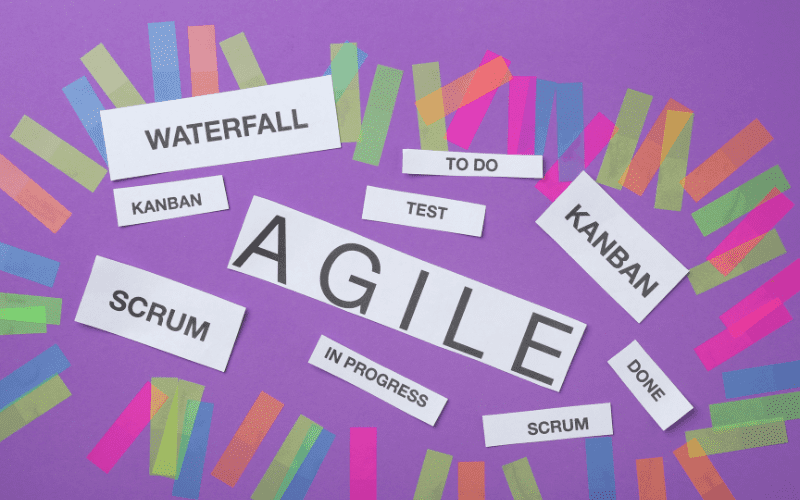Tired of design projects that feel rigid and unresponsive? Traditional methods often struggle to adapt to changing needs, leaving you with a final product that misses the mark. Agile design offers a refreshing alternative.
Introduction to Agile Design
This flexible approach prioritizes collaboration and continuous feedback, ensuring your design stays relevant and user-centered throughout the entire development process. With Agile, you can build user-centric products faster and more efficiently.
Embracing Agile methodologies requires deep understanding and professional execution. Codewave, with its pioneering approach in design-led tech development, has mastered this adaptability to ensure your project always meets the evolving market demands.
Agile Design Practices
Embrace Flexibility, Not Rigidity: Agile Design in Action
- Adaptability: The Core of Agile Design
Unlike traditional methods that get bogged down in upfront planning, Agile design thrives on adaptability. It’s a toolbox of practices that lets the design evolve organically as the project progresses, constantly informed by user needs, development progress, and overall feedback.
- Planning with Flexibility: A Blueprint, Not a Cage
This doesn’t mean there’s no plan – Agile teams start with a basic blueprint to guide them. But the key is staying flexible. Think of it like building a house: you have a foundation, but you can adjust the layout as you go based on what works best.
- Tools in the Agile Toolbox: Test-Driven Development and Beyond
One powerful Agile practice is Test-Driven Development (TDD). Here, developers write tests before the actual code, ensuring high quality and early feedback. But TDD is just one tool in the Agile belt. Agile values flexibility, so the specific practices used depend on your project and team.
By embracing this adaptability, Agile design empowers teams to respond quickly to changes, minimize technical debt, and ultimately deliver exceptional user experiences.
Collaborative and Iterative Design
- Incorporation of customer and developer insights
Agile design thrives on collaboration, integrating insights from both customers and developers throughout the design process. This ensures the final product not only meets user needs but also aligns with technical feasibility.
- Iterative design alongside software architecture
Agile design fosters a highly iterative process, enabling design and software architecture to evolve through multiple iterations. This iterative nature ensures that design and development mutually inform and improve each other.
- Engagement with development team for continuous improvement
Collaboration extends beyond incorporating user feedback, involving the development team in continuous improvement. Strategies such as joint design reviews, shared backlog refinement, pairing on design tasks, and effective use of bug tracking tools create a collaborative environment.
Agile as a Delivery Process
- Critique of using Agile solely as a design framework
Agile is a software development methodology with a powerful set of principles that can be effectively applied to design as well. While Agile isn’t solely focused on design, it fosters a collaborative environment where design and development work hand-in-hand. This is achieved by embracing iterative cycles, continuous feedback, and adaptability throughout the entire project lifecycle.
- Proposal for a dual-track process combining design and delivery
A dual-track Agile approach ensures that design decisions directly influence development, and vice versa. This integrated approach, combining design and delivery, maximizes the advantages of Agile in creating successful and user-centric products.
- Emphasis on valuable upfront work and process flexibility
Agile prioritizes valuable upfront work that lays a solid foundation without getting bogged down in excessive details. This emphasis on upfront work, combined with flexibility, ensures a strong start for the project.
Consider leveraging Codewave’s expertise in orchestrating a dual-track Agile process that intelligently marries design with delivery, ensuring your product is not just built well but is truly designed for success.
Design Throughout the Agile Lifecycle

- Continuous design during the software development lifecycle
Agile design extends beyond the initial concept phase, persisting throughout the software development lifecycle. This lifecycle perspective ensures that design remains relevant and user-centered throughout the project’s journey.
- Integration of Agile Model Driven Development (AMDD)
Agile design is complemented by Agile Model Driven Development (AMDD), which involves continuous design reviews, user story refinement as a design tool, and the creation and maintenance of a living style guide.
- Role of Test-Driven Development (TDD) in design
Test-Driven Development (TDD) plays a crucial role in Agile design by testing design assumptions, encouraging refactoring, and providing early feedback on code functionality.
Maximizing User Experience in Agile Design
- Importance of user experience design over visual aesthetics
Agile design prioritizes user experience (UX) over visual aesthetics. The primary focus is on creating a product that is intuitive, user-friendly, and addresses user pain points.
- Designers as key feedback sources for UX improvements
Designers play a crucial role as the voice of the user within the Agile team. They actively gather and integrate user feedback using methods such as user research, usability testing, interviews, surveys, card sorting, and A/B testing.
- Balancing between functional and visual aspects of design
While visual aesthetics play a role, Agile design balances the functional and visual aspects of design. The goal is to create a seamless and user-centric experience that goes beyond mere visual appeal.
Future-Proofing Design
- Adapting to evolving development paradigms
Agile design’s emphasis on adaptability helps projects stay future-proof. This involves incorporating new development approaches, like microservices architectures that break down complex systems into smaller, independent components. Additionally, Agile teams leverage technologies that separate design and logic, allowing for easier design updates without recoding entire functionalities. While automated testing is a cornerstone of Agile, continuous integration and continuous deployment (CI/CD) practices play a larger role in future-proofing by enabling frequent updates and rapid response to changing needs.
- Utilization of technologies for logical and design separation
Separating logic from design using technologies ensures that designs remain adaptable to future changes. This separation contributes to design resilience and flexibility.
- Ensuring design resilience through automated testing
Automated testing plays a crucial role in future-proofing design by facilitating early detection of design flaws, maintaining design intent, and supporting refactoring and codebase evolution.
- Case Study: Automated Testing for a Search Feature Redesign
Developers can create automated tests to ensure core functionalities such as search suggestions, filter options, and product sorting function as expected after a design change.Developers can create automated tests to ensure core functionalities such as search suggestions, filter options, and product sorting function as expected after a design change. This ensures a smooth user experience despite significant design alterations.
Conclusion
- Benefits of integrating Agile design into software development
Integrating Agile design offers numerous benefits, fostering continuous improvement, prioritizing user feedback, and creating a collaborative environment. While Agile is a comprehensive development methodology with core principles that extend beyond design, these principles can be applied to inform and improve design processes. Instead of fundamentally altering Agile itself, design teams can leverage its adaptability to create a workflow that aligns with their specific design philosophies. This might involve incorporating design-centric practices alongside core Agile principles to achieve an optimal approach for a particular project.
As you consider integrating Agile design principles into your projects, partnering with a company like Codewave could be the difference-maker, blending design thinking and tech development expertise to bring your vision to life efficiently and effectively.
- The necessity of adapting Agile practices to fit design philosophies
While Agile provides a flexible and efficient approach to software creation, its practices should be adapted to align with specific design philosophies. This ensures a harmonious integration that leads to successful and user-centric products.
- Agile design as a flexible and efficient approach to software creation
In conclusion, Agile design is a flexible and efficient approach that, when integrated into the software development process, results in successful and user-centric products. Its principles and practices provide a framework for continuous improvement and adaptability in a rapidly evolving software landscape.
Get started with Agile Design today!
Codewave is a design thinking led digital transformation company enabling organisations with playful innovation using AI & ML, IoT & Edge, AR, VR, Cloud, Blockchain, and Data.







